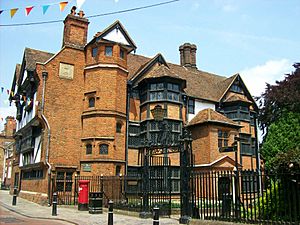Eastgate House, Rochester facts for kids
Quick facts for kids Eastgate House |
|
|---|---|

Eastgate House
|
|
| OS grid reference | TQ74486833 |
| Built | 1590/1 |
| Built for | Sir Peter Buck |
| Governing body | Eastgate House Trust |
| Type | Grade II* |
| Designated | 24 October 1950 |
| Reference no. | 1086482 |
| Lua error in Module:Location_map at line 420: attempt to index field 'wikibase' (a nil value). | |
Eastgate House is a really old and special house in Rochester, Kent, England. It was built a long, long time ago, in the 1590s! This house is famous because it's connected to the well-known writer Charles Dickens. He even wrote about it in two of his books, The Pickwick Papers and The Mystery of Edwin Drood. Today, Eastgate House is a museum where you can learn all about Dickens and the history of the house. You can even see the small wooden house, called a Swiss chalet, where Dickens wrote some of his famous stories!
Contents
The Story of Eastgate House
Eastgate House was built around 1590 for a man named Sir Peter Buck. He was the Mayor of Medway and worked at Chatham Dockyard. After Sir Peter Buck, his family lived in the house for about 100 years.
Eastgate House as a School
Later, in the 1700s, Eastgate House became a school. It was first mentioned as a free school in 1772. A free school was a place where children could get an education without their families having to pay. In 1841, it changed into a Victorian boarding school for girls. This meant the girls lived at the school while they studied.
Dickens' Connection to Eastgate House
The house became very famous because of its link to Charles Dickens. He used Eastgate House as inspiration for places in his novels. In The Pickwick Papers, published in 1836, he called it 'Westgate'. Later, in The Mystery of Edwin Drood (1870), he named it the 'Nun's House'.
From Private Home to Public Museum
In the 1870s, Eastgate House became a private home again. It was owned by a man named Samuel Shaw, who sold coal. After that, it was used as a hostel for young men in 1890. Then, in 1897, it became a restaurant that didn't serve alcohol, known as a temperance restaurant.
In 1903, the city council of Rochester turned the building into a public library and museum. This was done to celebrate Queen Victoria's Diamond Jubilee. From 1923, it was used as a Dickens Museum. The special Swiss chalet where Dickens wrote was moved to the grounds of Eastgate House in the 1960s.
The Dickens Centre at Eastgate House closed in 2004. However, in 2012, Medway Council received money to make the house even better. They wanted to turn it into a place for art and history events. The house reopened in July 2017 and is now open to visitors on Thursdays, Fridays, and Saturdays.
The House's Design
Eastgate House is made of brick, and its outside walls are quite old and delicate. Inside, there's a beam in one of the upstairs rooms that shows the date 1591. When the house was being fixed up recently, workers found some cool things. They discovered a mysterious drawing of a man's face from the 1500s hidden under layers of paint! They also found a pattern of black lines that looked like another old painting.
The Grounds of Eastgate House
When Eastgate House was first built, its gardens were huge! They stretched out a long way in different directions. In the 1920s, a designer named Sir Guy Dawber helped create the gardens, a small extra building, and a cottage on the property. The most famous part of the grounds today is the Swiss chalet where Charles Dickens wrote.

